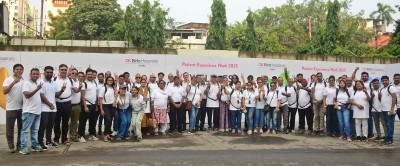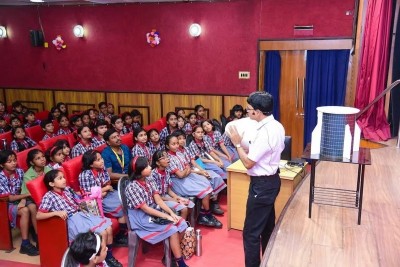December 14, 2025 03:44 pm (IST)
ATLAS and CMS experiments shed light on Higgs properties
Geneva/Saint Petersburg, Sept 1 (IBNS): Three years after the announcement of the discovery of a new particle, the so-called Higgs boson, the ATLAS and CMS Collaborations presented for the first time combined measurements of many of its properties, at the third annual Large Hadron Collider Physics Conference (LHCP 2015).
By combining their analyses of the data collected in 2011 and 2012, ATLAS and CMS draw the sharpest picture yet of this novel boson.
The new results provide in particular the best precision on its production and decay and on how it interacts with other particles. All of the measured properties are in agreement with the predictions of the Standard Model and will become the reference for new analyses in the coming months, enabling the search for new physics phenomena. This follows the best measurement of the mass of the Higgs boson, published in May 2015 after a combined analysis by the two collaborations.
“The Higgs boson is a fantastic new tool to test the Standard Model of particle physics and study the Brout-Englert-Higgs mechanism that gives mass to elementary particles,” said CERN Director General Rolf Heuer. “There is much benefit in combining the results of large experiments to reach the high precision needed for the next breakthrough in our field. By doing so, we achieve what for a single experiment, would have meant running for at least 2 more years.”
There are different ways to produce a Higgs boson, and different ways for a Higgs boson to decay to other particles. For example, according to the Standard Model, the theory that describes best forces and particles, when a Higgs boson is produced, it should decay immediately in about 58% of cases into a bottom quark and a bottom antiquark. By combining their results, ATLAS and CMS determined with the best precision to date the rates of the most common decays.
Such precision measurements of decay rates are crucially important as they are directly linked to the strength of the interaction of the Higgs particle with other elementary particles, as well as to their masses.
“The Higgs boson is a fantastic new tool to test the Standard Model of particle physics and study the Brout-Englert-Higgs mechanism that gives mass to elementary particles,” said CERN Director General Rolf Heuer. “There is much benefit in combining the results of large experiments to reach the high precision needed for the next breakthrough in our field. By doing so, we achieve what for a single experiment, would have meant running for at least 2 more years.”
There are different ways to produce a Higgs boson, and different ways for a Higgs boson to decay to other particles. For example, according to the Standard Model, the theory that describes best forces and particles, when a Higgs boson is produced, it should decay immediately in about 58% of cases into a bottom quark and a bottom antiquark. By combining their results, ATLAS and CMS determined with the best precision to date the rates of the most common decays.
Such precision measurements of decay rates are crucially important as they are directly linked to the strength of the interaction of the Higgs particle with other elementary particles, as well as to their masses.
Therefore, the study of its decays is essential in determining the nature of the discovered boson. Any deviation in the measured rates compared to those predicted by the Standard Model would bring into question the Brout-Englert-Higgs mechanism and possibly open the door to new physics beyond the Standard Model.
“This is a big step forward, both for the mechanics of the combinations and in our measurement precision,” said ATLAS Spokesperson Dave Charlton. “As an example, from the combined results the decay of the Higgs boson to tau particles is now observed with more than 5 sigma significance, which was not possible from CMS or ATLAS alone.”
“Combining results from two large experiments was a real challenge as such analysis involves over 4200 parameters that represent systematic uncertainties,” said CMS Spokesperson Tiziano Camporesi. “With such a result and the flow of new data at the new energy level at the LHC, we are in a good position to look at the Higgs boson from every possible angle”.
“This is a big step forward, both for the mechanics of the combinations and in our measurement precision,” said ATLAS Spokesperson Dave Charlton. “As an example, from the combined results the decay of the Higgs boson to tau particles is now observed with more than 5 sigma significance, which was not possible from CMS or ATLAS alone.”
“Combining results from two large experiments was a real challenge as such analysis involves over 4200 parameters that represent systematic uncertainties,” said CMS Spokesperson Tiziano Camporesi. “With such a result and the flow of new data at the new energy level at the LHC, we are in a good position to look at the Higgs boson from every possible angle”.
Support Our Journalism
We cannot do without you.. your contribution supports unbiased journalism
IBNS is not driven by any ism- not wokeism, not racism, not skewed secularism, not hyper right-wing or left liberal ideals, nor by any hardline religious beliefs or hyper nationalism. We want to serve you good old objective news, as they are. We do not judge or preach. We let people decide for themselves. We only try to present factual and well-sourced news.
Support objective journalism for a small contribution.
Latest Headlines
Modi’s ₹1 lakh crore tech push! India unveils game-changing innovation scheme at ESTIC 2025
Mon, Nov 03 2025
CMS-03: ISRO launches its 4.4-tonne heaviest communication satellite to boost Navy's communication grid
Sun, Nov 02 2025
Trio wins Nobel Prize in Chemistry for developing new form of molecular architecture
Wed, Oct 08 2025







